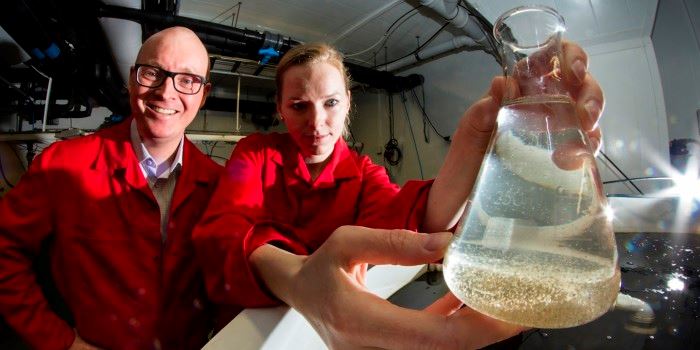Unique technology from SINTEF, NOK 13 million in fresh capital and an annual market potential of NOK 2 billion are the ingredients of the new factory which is located outside Trondheim in Norway.
Facts about copepods
- Copepods are found in enormous numbers in the sea and in freshwater.
- They are the natural baby food of most marine species.
- While salmon fry can eat dry feed from day one, saltwater species need live start-feed.
- About 8500 copepod species exist all over the world. The species that C-Feed is cultivating is Acartia tonsa, which grows to a length of about 1 – 2 mm.
C-Feed, a spin-off from SINTEF which is Scandinavia’s largest independent research organisation, has so far produced copepods; natural baby food of most marine species, on a small scale in Trondheim. When the new plant opens in the autumn, the company will start by increasing its production by a factor of ten.
Feed for baby fish
The tiny crustaceans will be used as live feed for fry of ballan wrasse, tuna, lobster, halibut and other marine species. Many companies and researchers across the world have tried without success to cultivate new species, and it is often the fry stage that has been the problem, because a large proportion of the young fish die during this early phase of production.
“Until now, cultivating tuna has been an extremely demanding, not to say impossible, process. Our copepods have turned out to be very suitable as baby food for fry, and we believe that tuna could represent a major market for us, since tuna are in great demand with sushi enthusiasts all over the world,” says C-Feed CEO Rune Bjerke.
The copepods are also very likely to revolutionise the cultivation of well-known farmed species such as halibut, lobster and ballan wrasse.
Ready to fight plagues of lice
Bjerke points to ballan wrasse cultivation as having great market potential, particularly in Norway. Wrasse are in demand because they eat lice that live on the skin of salmon held in fish-cages, and are therefore among the most effective methods of combatting plagues of lice. “The production of fish-feed for ballan wrasse farmers could become our largest market in Norway,” says Bjerke.
Facts about C-Feed
- The company was founded in April 2014, following more than 10 years of research at SINTEF.
- Its majority shareholder is SINTEF Venture IV, which holds about 80 per cent of the equity capital. Other owners include CoFounder AS, Investitude AS, Solar Materials AS and key members of the board.
- C-Feed estimates that in the course of ten years or so, the annual global market for copepods will be worth almost NOK 2 billion. Of this, about half is linked to existing farmed species (ballan wrasse, halibut, cod, sole and turbot), and the other half to new farmed species such as tuna or squid.
- The company’s main product is copepod eggs, which its clients will then hatch and on-grow themselves to the size they need in the course of about 12 days. The eggs are no bigger than a grain of sand, and thus are easy to distribute to customers all over the word.
C-Feed has now attracted NOK 13 million from new investors, existing shareholders and Innovation Norway. The extra capital will be used to build and operate a new factory in Vanvikan outside Trondheim, which will enable production to be increased by a factor of ten compared to the company’s present site. The capacity of the new plant will be capable of being further increased by a factor of four.
“We are greatly looking forward to making the jump from small-scale production to the industrialisation of copepod cultivation,” says Bjerke.
The company has already started small-scale exports to customers in several European countries, and expects that its turnover will be in the region of NOK 10 million in the first full year of operation of the new plant.
New managing director
Since the company was founded, C-Feed has been built up under an interim management provided by CoFounder AS, a Trondheim-based management and investment company for early-phase technology companies. “Bringing in Rune Bjerke and CoFounder in the establishment phase worked very well. Now that we are approaching the industrialisation phase, the natural next step is to find a new company head,” says Jostein Bjøndal of SINTEF Venture. The company board is already looking out for a new managing director.
Contact person:
Rune Bjerke, CEO of C-Feed AS
Tel: +47 47 900 479
Email:

